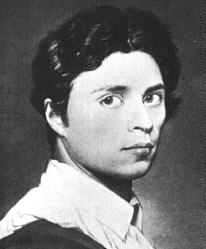
|
Ingres was born in Montauban on August 29, 1780, the son of an unsuccessful sculptor and painter. He entered the studio of the neoclassical painter Jacques Louis David in Paris in 1797 and won the Prix de Rome in 1801 for his painting The Ambassadors of Agamemnon (École des Beaux-Arts, Paris). From 1806 to 1820 he painted in Rome, where he developed his extraordinary gifts for drawing and design. He was greatly influenced by the work of the Italian Renaissance painter Raphael, and his style has been described as doubly inspired by Raphael and David. While in Italy, Ingres made many pencil portraits that are distinguished for purity and economy of style. In 1820 he left Rome and went to Florence for four years.
On his return to Paris, Ingres won great acclaim with The Vow of Louis XIII (1820), commissioned for the Cathedral of Montauban and exhibited in the Paris Salon in 1824. He became the recognized leader of the neoclassical school that opposed the new romantic movement led by Eugene Delacroix and Theodore Gericault. During this period Ingres painted The Apotheosis of Homer (1827) for a ceiling in the Louvre in Paris. Angered by the poor reception given his Martyrdom of Saint Symphonrian (1834, Autun Cathedral), he left Paris to accept the directorship of the French Academy at Rome in 1834. At the end of his seven-year term as director he returned again to Paris and was welcomed as one of the most celebrated painters in France. His position both as a painter and as the official academic spokesman against the romanticists was established, and he was given the rank of commander of the Legion of Honor in 1845. In the Universal Exhibition of Paris in 1855 both he and Delacroix, his chief rival in art, were awarded gold medals. Ingres died in Paris on January 14, 1867.
Ingres's strengths—superb draftsmanship, keen sensitivity for personality, and precise neoclassical linear style—were perfectly suited to portraiture. Mme. Moitessier (1851, National Gallery of Art, Washington, D.C.) and La Comtesse d'Haussonville (1845, Frick Collection, New York City) are outstanding examples, and M. Bertin (1832, Musée du Louvre) is considered one of the finest portraits of the 19th century. Ingres continued to paint vigorously in his old age, producing in his 82nd year his famous Turkish Women at the Bath (1863, Musée du Louvre), the culmination of his superb depictions of female nudes. Ingres's influence on art to the present day has been immense; among important later painters who acknowledged deriving inspiration from his style are Edgar Degas, Pierre Auguste Renoir, Henri Matisse, and Pablo Picasso.
|


